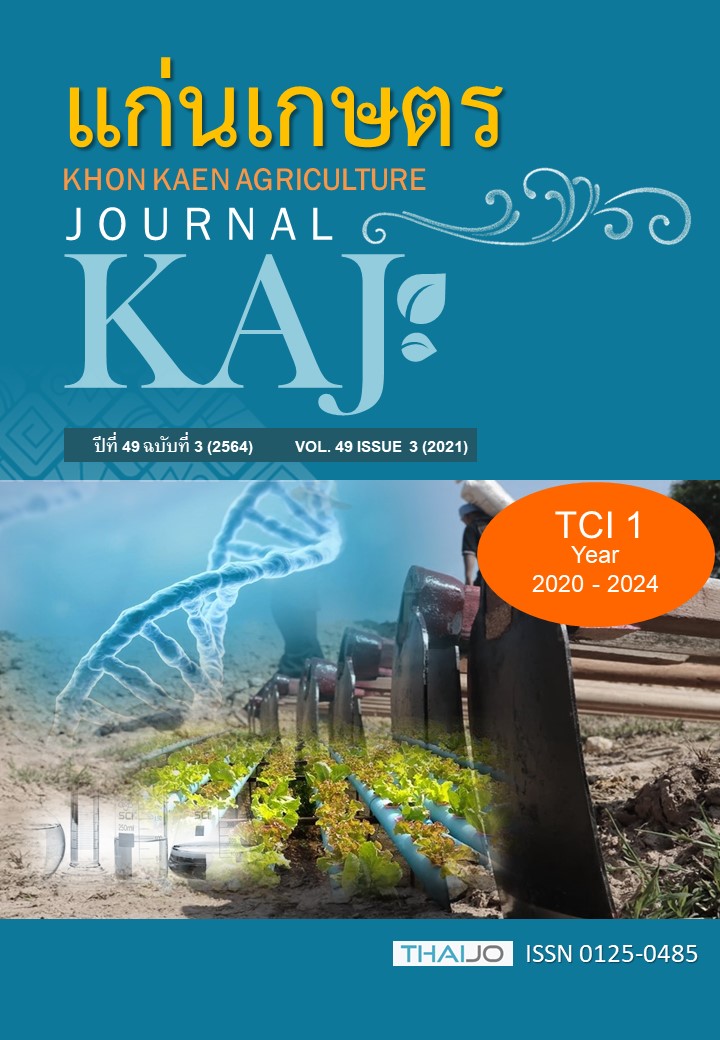ผลของแคลเซียมซิลิเกตจากอุตสาหกรรมซีเมนต์ต่อการเจริญเติบโต ผลผลิต และการสะสมซิลิกอนของข้าวสายพันธุ์ไรซ์เบอร์รี่และทับทิมชุมแพ
Main Article Content
บทคัดย่อ
ข้าว (Oryza sativa L.) เป็นพืชอาหารหลักและพืชเศรษฐกิจที่สำคัญของประเทศไทย ซึ่งปัจจุบันผู้บริโภคหันมาดูแลสุขภาพมากยิ่งขึ้น ทำให้ข้าวพันธุ์ไรซ์เบอร์รี่และข้าวพันธุ์ทับทิมชุมแพได้รับความนิยม เนื่องจากมีโภชนาการและสารต้านอนุมูลอิสระสูง ลดความเสี่ยงของการเกิดโรคมะเร็ง ข้าวเป็นพืชที่สามารถสะสมซิลิกอนในเนื้อเยื่อพืช ซึ่งมีผลทางอ้อมที่ทำให้ผลผลิตพืชเพิ่มขึ้น แต่ว่าปัจจุบันซิลิกอนเริ่มมีราคาสูงขึ้นจึงมีการนำวัสดุเหลือใช้จากอุตสาหกรรมซีเมนต์ที่สามารถนำมาใช้เป็นแหล่งของซิลิกอนในการปลูกข้าว วัตถุประสงค์ของการวิจัยนี้เพื่อศึกษาอัตราแคลเซียมซิลิเกตจากอุตสาหกรรมซีเมนต์ที่ต่างกันต่อการเจริญเติบโตและผลผลิตของข้าวทั้ง 2 สายพันธุ์ ใช้แคลเซียมซิลิเกต 5 ระดับ คือ 0, 200, 400, 600 และ 800 กก./ไร่ วางแผนการทดลองแบบ 2×5 Factorial in CRD โดยทำการทดลองในกระถางภายใต้สภาพโรงเรือน ผลการทดลองพบว่า การใส่แคลเซียมซิลิเกตอัตรา 200, 400, 600 และ 800 กก./ไร่ ไม่มีผลทำให้ผลผลิตข้าวมีความแตกต่างกันทางสถิติ แต่มีแนวโน้มว่าการใส่แคลเซียมซิลิเกตอัตรา 200, 400 และ 600 กก./ไร่ ให้ผลผลิตสูงกว่ากรรมวิธีที่ไม่มีการใส่แคลเซียมซิลิเกต 13.15, 6.11 และ 6.07 % ตามลำดับ ในการศึกษานี้ยังพบว่าข้าวพันธุ์ทับทิมชุมแพให้ผลผลิตสูงกว่าพันธุ์ไรซ์เบอร์รี่อย่างมีนัยสำคัญยิ่งทางสถิติ (P≤0.01) การสะสมซิลิกอนในส่วนของลำต้น รวง และแกลบ ไม่มีความแตกต่างกันทางสถิติระหว่างข้าวทั้งสองสายพันธุ์
Article Details

อนุญาตภายใต้เงื่อนไข Creative Commons Attribution-NonCommercial-NoDerivatives 4.0 International License.
เอกสารอ้างอิง
กองวิจัยและพัฒนาข้าว กรมการข้าว. 2559. องค์ความรู้เรื่องข้าว. แหล่งข้อมูล: http://www.ricethailand.go.th/rkb3/title-index.php-file=content.php&id=19.htm. ค้นเมื่อ 30 ธันวาคม 2563.
คมชัดลึก. 2560. เทรนด์อาหาร 2018 เสริม “สุขภาพ-ความงาม” มาแรง. แหล่งข้อมูล: http://www.nationtv.tv/main/content/378560225/. ค้นเมื่อ 14 มิถุนายน 2563.
ยงยุทธ โอสถสภา. 2552. ธาตุอาหารพืช. พิมพ์ครั้งที่ 3. สำนักพิมพ์มหาวิทยาลัยเกษตรศาสตร์, กรุงเทพฯ.
สมชาย ชคตระการ. 2560. ผลของการใช้วัสดุเหลือทิ้งจากอุตสาหกรรมผลิตซีเมนต์ต่อการเจริญเติบโตและผลผลิตข้าวพันธุ์ปทุมธานี1. วารสารวิทยาศาสตร์และเทคโนโลยี. 25(1): 66-74.
Balasta, M. L. F. C., C. M. Perez, B. O. Juliano, C. P. Villareal, J. N. A. Lott, and D. B. Roxas. 1989. Effect of silica level on some properties of Oryza sativa straw and hull. Canadian Journal of Botany. 67(8): 2356-2363.
Chumjit, S., W. Sangartit, U. Kukongviriyapan, P. Pakdeechote, V. Kukongviriyapan, and S. Thawornchinsombat. 2017. Effects of Tubtim Chum Phae rice bran hydrolysates on blood pressure and oxidatives stress in L-NAME-induced hypertensive rats. KKU research journal. 17(3): 19-29.
Doberman, C., and T. Fairhurst. 2000. Rice: Nutrient Disorders and Nutrient Management. Potash and Phosphate Institute, Canada and International Rice Research Institute, The Philippines.
Inanaga, S., Y. Higuchi, and N. Chishaki. 2002. Effect of silicon application on reproductive growth of rice plant. Journal of Plant Nutrition. 48(3): 341-345.
Kaerlek, W.J. 2012. Effect of silicon on plant growth and drought stress tolerance. All Graduate Theses and Dissertations. Utah State University.
Kazunori, T., and J. F. Ma. 2008. Reexamination of silicon effects on rice growth and production under field conditions using a low silicon mutant. Plant Soil. 307(1): 21-27.
Liu, J., S. Rahman, S. Sriboonchitta, and A. Wiboonpongse. 2017. Enhancing productivity and resource on conservation by eliminating in efficiency of Thai rice farmers: A zero in efficiency stochastic frontier approach. Sustainability-Basel. 9(5): 1-18.
Ma, J. F., K. Nishimura, and E. Takahashi. 1989. Effect of silicon on growth of rice plant at different growth stages. Soil Science and Plant Nutrition. 35(3): 347-356.
Ma, J.F., and E. Takahashi. 2002. Soil, fertilizer and plant silicon research in Japan. 1st Edition. Elsevier Science. Dordrecht.
Nayar, P. K., A. K. Misra, and S. Patnaik. 1975. Rapid microdetermination of silicon in rice plant. Plant Soil. 42(2): 497-494.
Wattanapayapkul, W., A. Polthanee, B. Siri, N. Na Bhadalung, and A. Promkhambut. 2011. Effects of silicon in suppressing blast disease and increasing grain yield of organic rice in Northeast Thailand. Asian Journal of Plant Pathology. 5(4): 134-145.


